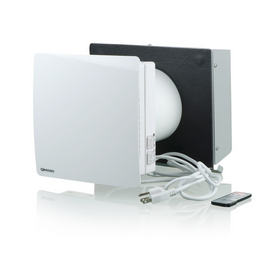
A Modernist Tiny Home Prepares to go Off-Grid
Last Updated: Apr 13, 2025Mention “tiny home” and this charming biophilic home in Portland might come to mind. Or this 500-square-foot cabin-like home in West Virginia. Or this mod box built on a gooseneck trailer with prof-chef kitchen near San Francisco Bay. Or this tiny house that unfolds into a castle on wheels in New Zealand.
Table of Contents
- Tiny Footprint, Off-Grid Potential
- Functionality and Finishes
- Start Downsizing Now

What might not come to mind is Lisa and Matt Hobbs’s black, ultra-modern 237-square-foot home, into which they brilliantly finessed a full-sized kitchen, bathroom, and a king-sized bed. Owners of the Tailored Tiny Company in Australia, the Hobbses say that the tiny house movement drew their attention as a way to reduce their environmental impact and live more sustainability.
“The creativity expressed, as well as the challenge of creating a small functioning space, without losing the comforts of a large house, is what drew us to start designing and building our own tiny home,” according to their website. What they created is strikingly original.

Tiny Footprint, Off-Grid Potential
Q: How did you get interested in the tiny home movement?
A: I’ve been interested in tiny houses for about six years, with the goal of building or buying one at some stage. Matt was thinking of making a shipping-container house before we met. When I mentioned the tiny houses on our first date, it planted a seed and not long after we were in the process of designing and building.

Functionality and Finishes
Q: Describe the design of the interior.
A: The design focuses on the necessities of a regular home. We broke our lifestyle into four main rooms: the bedroom, bathroom, kitchen, and lounge. We asked what we needed in a home. This was all we needed. The bedroom also had to be comfortable and accessible. The bathroom, being our substitute “office,” had to accommodate both of us at once. The kitchen needed to be completely functional, or it wouldn’t be used. The couch had to be big enough for both of us to lounge.
Energy Saving Products for the Home
Shop home improvement products that help save and conserve energy (power) in your home.

Vents TwinFresh Comfo RA1-50-2 Ductless Energy Recovery Ventilator
Vents
In Stock

Stiebel Eltron Accelera 300 E Heat Pump Water Heater
Stiebel Eltron
Out of Stock

AFM Safecoat Almighty Adhesive Case of 12
AFM Safecoat
In Stock

Emporia Classic Level 2 48 AMP EV Charger UL Listed
Emporia
In Stock
2 Colors

Stiebel Eltron CON 300-2 Premium Wall-Mounted Convection Heater - 202030
Stiebel Eltron
Out of Stock

Santa Fe Compact70 Dehumidifier - 4044110
Santa Fe
In Stock

AFM Safecoat 3 in 1 Adhesive
AFM Safecoat
In Stock

QuickBOLT QB2 with Microflashing Multi Roof Mount Solar Panel Fastener Kit
QuickBOLT
In Stock

Stiebel Eltron DHC-E 8/10-2 Plus Point-of-Use Electric Tankless Water Heater - 202145
Stiebel Eltron
In Stock

Stiebel Eltron Accelera 220 E Heat Pump Water Heater
Stiebel Eltron
In Stock

Q: Is there anything you miss?
A: Not at all. An essential part of the design was functionality. Everything has its place. Everything has a purpose. Because we didn’t skimp on the quality of the finishes, the house feels just like a typical house, just slightly smaller.
Tobias Roberts
Tobias runs an agroecology farm and a natural building collective in the mountains of El Salvador. He specializes in earthen construction methods and uses permaculture design methods to integrate structures into the sustainability of the landscape.









